|
|
32cm Wimshurst Influence Machine |
|

|
Setup used in these images. 32cm disks made from 2.5mm high density polystyrene. Disk spacing set to 4.5mm. 24 sectors made from adhesive aluminium tape - sectors are approx' 1.9cm at widest point. All 4mm and 6mm brass tube conductors. Large sphere (37.5mm) - Ping-Pong ball covered in smoothed aluminium tape. Small ball - chromed plastic bead 24mm diameter. Neutralising bar brushes are a few strands of fine copper wire. Disk bosses - hand turned from dense wood, lower drive wheels - 75mm pram wheels, tyres removed. Conductor supports are fibreglass lowers and PVC tubing uppers. Capacitor (Leyden jar) is a polycarbonate tube, inside lined with aluminium foil, outer "plates" approx' 5cm of same foil wrapped around each end. All images were generated at 1...2 turns of the crank per sec'.(1.8...3.6 disk turns/sec') The system maxed out at 13cm spark gap. The small image on left shows the positioning of a black background used for the long exposure close up photography. Black card on a wooden support, approx' 80mm from each conductor arm. Corona discharges were occasionally visible from the conductors to the card. Camera used for most images was a Starlight Xpress MX7C astronomy camera with a 28mm F2.8 lens.
|
|
 |
10 second exposure. 55mm sparks. A 10 second exposure of multiple (loud crack) sparks showing "blind" leaders and a small corona discharge just above main sparks on small ball.
Capacitor (Leyden jar) is connected to the near vertical rods behind spheres.
Spark gap is 55mm. Est' 165,000volts @ 3.3Kv/mm |
|
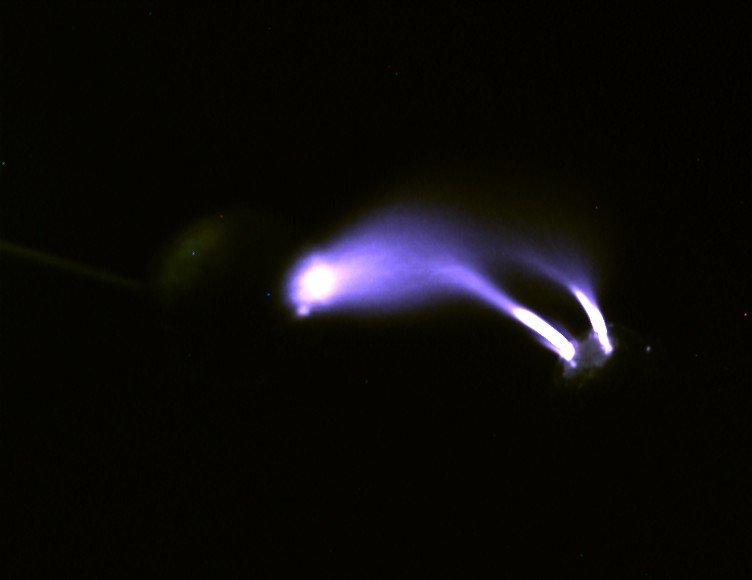 |
30 Second exposure. 45mm sparks.
A 30 second exposure of a "shower" of small sparks (popping sounds). The left expanding blue area is the main body of the sparks - streamers are visible. No leyden jars (capacitors) connected.
Spark gap is 45mm. Est' 140,000volts @ 3.3Kv/mm
|
|
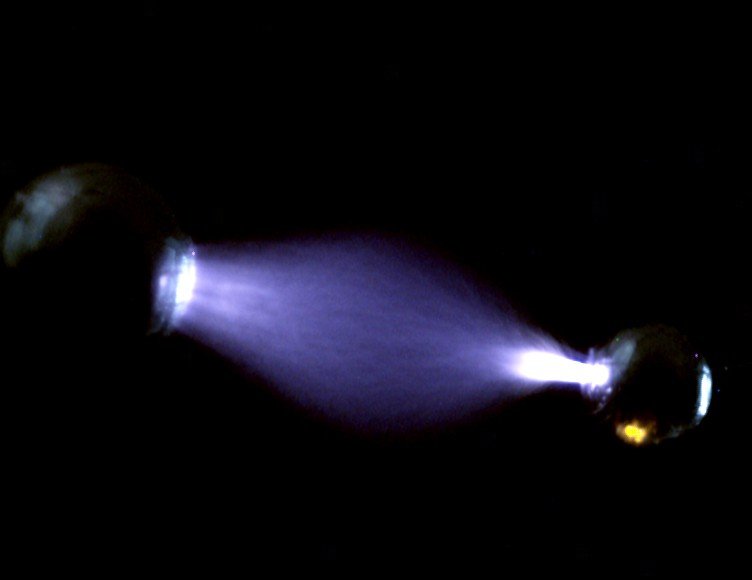 |
60 Second exposure. 80mm sparks.
A 60 second exposure of a "shower" of small sparks (popping sounds). The expanding blue area is the main body of the sparks - streamers are visible. No leyden jars (capacitors) connected.
Spark gap is 80mm. Est' 264,000volts @ 3.3Kv/mm
|
|
 |
60 Second exposure. 80mm corona discharge.
A 60 second exposure of a corona discharge, hissing sound. The expanding blue areas are the main body of the discharge exciting the air molecules No leyden jars (capacitors) connected. Small flaw (2mm square of aluminium tape) was fixed to small sphere to encourage corona discharge. Spark gap is 80mm.
|
|
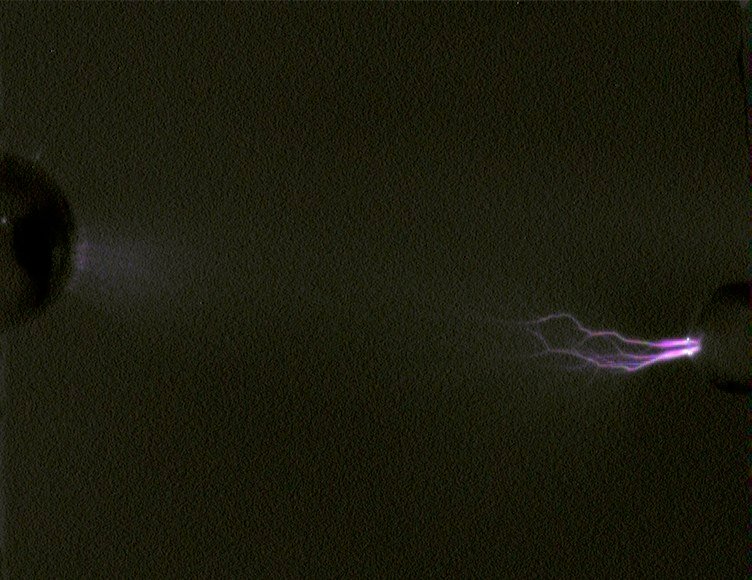 |
1 Second exposure. 130mm spark gap.
Short exposure showing leaders trying to get to the "other side". This was a very cold dry night, I had just cleaned the disks with alcohol, cleaned all the conductors and placed an insulating tube over the positive conductor arm. No signs of any corona discharge from any parts of the machine - except the sectors!
|
|
 |
1 Second exposure. 130mm spark gap.
Short exposure showing leaders still trying to get to the "other side". A few minutes after the previous image. |
|
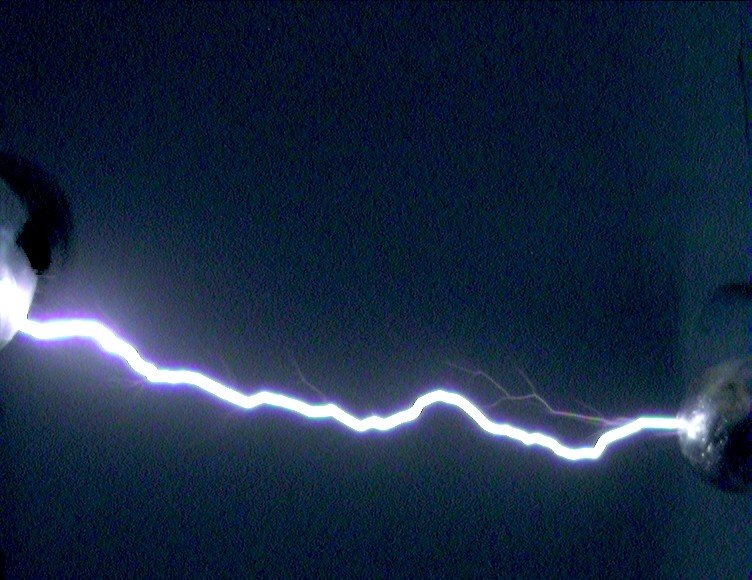 |
130mm spark. 10 second exposure.
It kept trying, a few small "popping" failed leaders and then with a very loud CRACK, 13cm spark - 90% of maximum design potential for 32cm/24/2cm disk machine. It managed several 130mm sparks but was blowing holes in the chrome plated 24mm ball, this increased the corona losses and dropped the max' output. Spark gap is 130mm. Est' 400,000volts @ 3.3Kv/mm
|
|
 |
Another 13cm spark, last it has done - so far. |
|
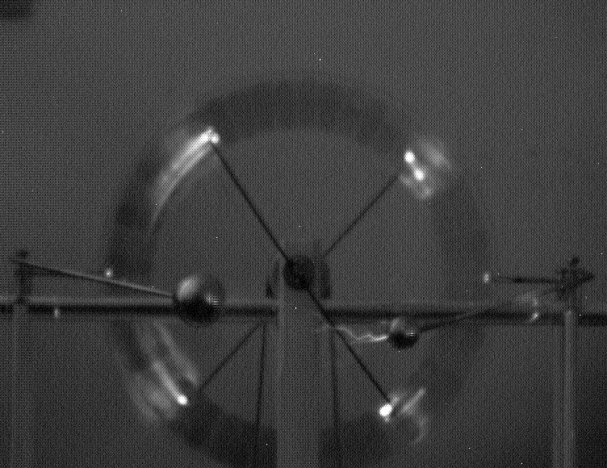 |
130mm spark gap leader. 30 second exposure - not colour converted. Discharges from sectors and collectors are clearly visible, along with a failed leader spark - small pop! Faint discharges are also visible from the ends of the foil capacitor "plates". No obvious corona discharge from the conductors and supports. The 13cm spark image above was taken just after this image. |
|
| A video of the 32cm in
operation. Unfortunately the video missed a couple of sparks - cracks can be heard! I need a better video camera. |
||
